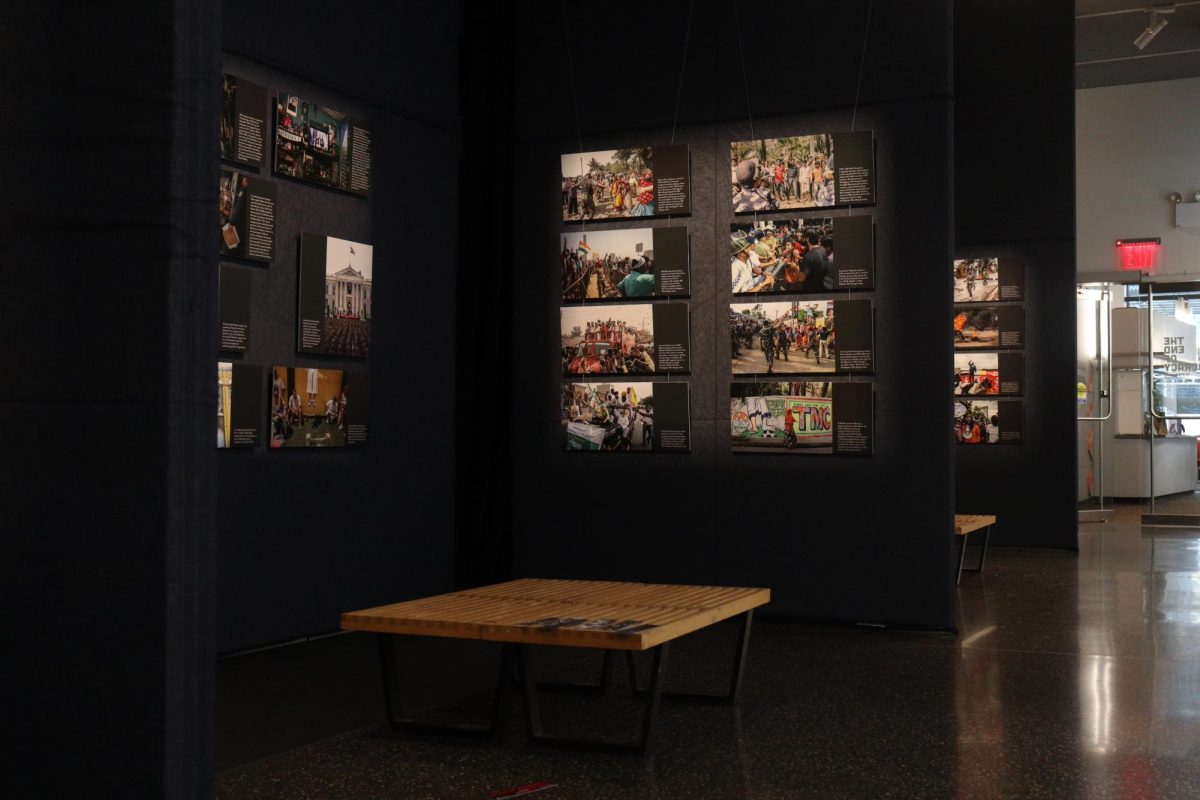Like a history book taking visual form, “The End of Democracy in Five Acts” beckons its viewer to observe and absorb, featuring intimate snapshots of power, humanity and corruption by a quintet of international photojournalists.
Displayed at NYU’s Gallatin Galleries, the Gallatin School of Individualized Study’s exhibition space, the showroom is divided into five collections of photographs, one for each represented country. Each image is paired with a plaque of text, providing contextual descriptions for the political moment.
The artists — Samson Otieno, Jit Chattopadhyay, Hannah Reyes Morales, Fred Ramos and Agata Szymanska-Medina — hail from countries across the globe: Kenya, India, the Philippines, El Salvador and Poland, respectively. Though each artist focuses on the political events occurring in their own country, all of the artworks are united under one common theme: narratives of unraveling democracies.
Upon entering the exhibition, the countless faces of protestors, politicians and police greet viewers. The space is dimly lit, perhaps intentionally shadowed in line with the dark subject matter, with gallery lights illuminating dozens of photographs.
“The idea that this is overwhelming — and maybe that the show is overwhelming by the nature of the quantity of photos and the amount of text in it — is by design,” Gallatin Professor Keith Miller said during the exhibition’s reception panel. Miller curated the exhibition along with fellow Gallatin professor Lauren Walsh.
The exhibition succeeds in overwhelming viewers — in the most thought-provoking way — through the sheer amount of evidence, information and history presented, drawing striking connections between authoritarianism abroad and its influence on the United States. The exhibition is especially impressive due to the geographical diversity of the content, presenting broad themes of representation and freedom that are universally resonant.
Szymanska-Medina’s collection utilizes a multimedia approach to tell the story of Poland’s illiberal democracy under the Law and Justice Party. Alongside more traditional photos of judges and protestors are screenshots from social media platform X and WhatsApp chats, displaying evidence of hate campaigns against critics of the government.
Polish judge and law professor Krystian Markiewicz, a target of social media vilification, is solemnly posing in a photograph, placed next to screenshots of a conversation involving a cyberbully named “Emi,” planning to publicly slander judges critical of the party’s platform. The contrast between the emotional snapshots of humanity and the blocks of text engage the viewer, while providing a background for the photos.
“I have to put things into context,” said Szymanska-Medina during the panel. “Because without context, it will not work.”
Centering the history and current realities of dictatorship in the Philippines, Reyes Morales’ images of Manila range from intriguing to chilling.
One photograph captures an unsettling pool of blood, reportedly from a gunshot victim, on a street under the sheen of a spotlight. The plaque next to the image explains that the photo shows the violence of “President Rodrigo Duterte’s bloody war on drugs.” All of Morales’ work is shot in the dark, conveying a feeling of secrecy and ambiguity. Each photo skillfully employs contrast — the darkened backgrounds draw the viewer’s eye to Morales’ subjects through vivid, almost harsh lighting that communicates the alarming nature of quiet authoritarian acts.
The body of work displayed in “The End of Democracy in Five Acts” acts as both art and a form of investigative reporting. A visit to the Gallatin Galleries will be an invaluable experience, and the exhibition’s home at NYU is appropriate. With the largest number of international students in the United States, NYU is undoubtedly a global institution, and developing an international understanding of politics and power is imperative.
Viewing these works not as separate entities, but as scenes playing out across an interconnected global history, is critical. This collection broadens its viewers’ understanding of power in an international context, allowing not only for cross-country solidarity, but also providing patterns of corruption — such as electoral violence and social media censorship — that we can look out for in our own nation. Further, the exhibition reminds viewers of the power of grassroots change, even in the most extreme environments, and prompts us to be civically engaged, locally and beyond.
“The End of Democracy in Five Acts” is open to the public, free of charge, at the Gallatin Galleries until Oct. 14.
Contact Sydney Chan and Chloe Claytor at [email protected].

























































































































































